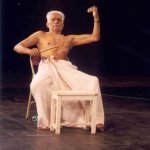Kathakali: the classical Indian theatre par excellence. Native to Kerala, a green region in south-west India, Kathakali in its current form dates back to the second half of the XVII century, but its golden age was around the half of last century.
Since the second half of the 19th century and for the first decades of the 20th, Kathakali suffered a widespread decline that deeply affected all the Indian culture under the British empire. Only in the last 40 years or so, thanks to some poet’s passion and to the intelligent initiative of the local government, Kathakali came back to its original splendor with an always growing verve and popularity. Kathakali’s popularity, a real myth for the western stage culture, is due essentially to technical rigor and to its actors’ legendary training. The lavish display of make-up and costumes, the hypnotic and sophisticated vocal and percussive music combined to the artistic mastery places this art on the highest levels of world theatre.
The performance
Classical Indian Kathakali dance-theatre is a complex universe in which various cultural and artistic realities merge together.
The idea that guides this introductive performance is to investigate that world to really get to know its richness. The performance is therefore organized with practice demonstrations of the Kalari (the gym where lessons take place) discipline.
There’s the part about working on the body (steps, positions, rhythm practice, mudra, simple units and complex aggregations of choreographic phrases, formulaic strings of different nature and extent); the one about the eyes (exercises and the reference to ekalochana, the practice of crying with one eye and laughing with the other one), the construction of the different parts of the drama, and so forth.
One part is about make-up (the make-up artist graduates after a couple years of lessons): colors, symbology, product nature, practice; the other ones are about music and the fundamental percussions (two different drums and cymbals) with practice without the instrument and the vocal organization of rhythm with its translation through percussions, etc.









